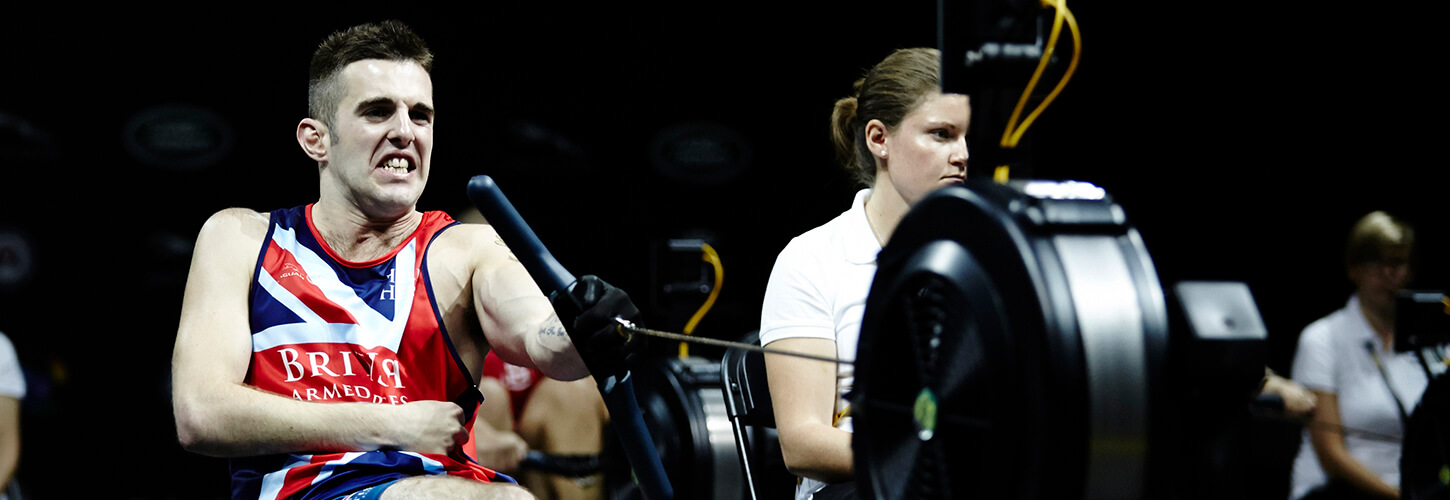
Adaptive rowing is for anyone who has a physical, sensory and learning impairment, or other movement challenges, temporary or long term.
Indoor adaptive rowing is possible using specially designed equipment, an adapted rowing stroke or different methods of communication.
When it comes to equipment, there is no ‘one size fits all’ solution, however there are a range of seating systems, additional tools and technologies available to suit different requirements.
Equipment | Top tips | How to |
|---|---|---|
A fixed flat seat can be used for those who have full trunk and arm function but are unable to use a sliding seat | Use a foam roller, rolled up mat or towel to keep a bend in your knees to reduce tension in your hamstrings | |
An upright fixed seat can be used for those who have no or limited trunk control | Ensure the chest strap is secure and not too tight or too loose, to allow movement when breathing. Adjust the backrest to an angle that suits you | |
A rotating exercise handle could be used by someone who only has use of one arm but can row with the legs or without legs | Try not to rotate too early in the drive to keep a linear movement | |
An all purpose gripping aid can be used by anyone with poor grip or using a rotating exercise handle | Make sure that the gripping aid is secure enough to not allow your grip to change | |
Software tools for those with a visual impairment | Cell |
How to start indoor rowing
If you are new to indoor rowing check out how to row using British Rowing technique and the useful 'How to' videos above (where applicable). Once you are familiar with the basic technique why not follow one of our training plans or try one of our Go Row Indoor workout videos - exercise alternatives can be found in the video description.
For more information and advice about adaptive rowing, email adaptive@britishrowing.org
Want to take your indoor rowing to the next level
If you would like to progress from indoor to on-water rowing, take a look at this adaptive rowing equipment page and guidance document detailing other adaptive equipment available, and find out more information here.
Indoor adaptive rowing competitions
Indoor rowing competitions take place across the country every year, culminating in the British Rowing Indoor Championships (BRIC) in December. These events are open to all, with many having specific adaptive races, and some requiring classification either in advance or on the day.
To compete in on-water or indoor adaptive events you will need to be classified by British Rowing. Further information on this process can be found here along with details of all the different classifications available. A breakdown of the Indoor Adaptive Rowing classifications can be found below.Indoor Adaptive Rowing Classifications |
|---|
IAR1 Competitors are unable to use their legs, with additional limitations in one or both arms. This includes complete C-spine SCI at T2 level and above. They use an upright or flat fixed seat |
IAR2 Competitors have no or minimal trunk function. They cannot pass the long sit test due to loss of power/stability and not chronic lower back pain, and have no lower limb function. They use an upright fixed seat with mandatory chest strap, due to them likely also having decreased sitting balance, with optional lap/pelvis straps |
IAR3 Competitors have upper limb impairment(s) (above wrist joint) and/or one leg/one arm on the same side impairment. They use a sliding seat and can choose to row with a single hand grip or a D-handle as required |
IAR4 Competitors have functional use of the trunk movement and who are unable to use the sliding seat because of significantly weakened function or mobility of the lower limbs. They can pass the long sit test but not the squat test. They use a flat fixed seat with optional leg straps |
IAR5 Competitors meet the minimum impairment criteria but are not eligible for any other physical impairment class. Competitors with a visual impairment must provide a BR/IG/FISA or IBSA sight loss form completed by an optometrist. They have functional use of their legs, trunk and arms for rowing and use the standard rowing set up (sliding seat) with hand grips allowed if grip is impaired |
IAR6 This is the Open category for those with chronic health conditions not resulting in physical impairment, or those with physical impairments not comparable with impairments in IAR1- IAR5. They must complete a self-declaration form that is submitted for approval ahead of the event |
More articles on Indoor Adaptive Rowing
